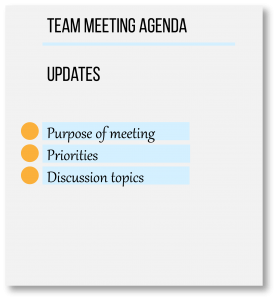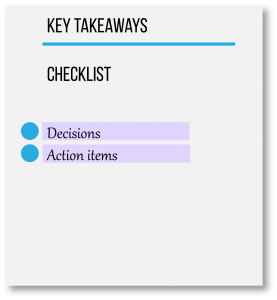Running a meeting seems simple in theory, but there are many factors that contribute to its success. Some data have shown that on average, only 50% of a meeting time is used effectively, and with the pandemic-induced surge in virtual meetings this past year, that figure may now be even lower.1
So how do you run a meeting that is both effective and engaging, whether it’s in person or through the screen? In this article, we will dive into the nuances of meeting science and important tips that you can apply right away to help improve the dynamics and efficacy of your meetings. Your team will thank you for it.
Table of Contents
Meeting Preparation

Like most things in life, taking the time to prepare will have a positive impact on the outcome. Anticipating the needs of the meeting and its participants will not only help the meeting run smoothly but also get everyone on the same page from the get-go.
Create and Distribute an Agenda
A meeting agenda should effectively map out the direction of the meeting, acting as an anchor to keep the group focused on the issues at hand. Circulated before the meeting, it should establish the purpose of the meeting, the topics that will be addressed in the order of priority, and the allotted time for each item. Having access to the agenda with sufficient time prior to the meeting will allow members to read any supporting background documents and do independent research in preparation. After all, discussions are much more engaging when everyone is on the same page and no one is playing catch up. Check out the eForms Meeting Agenda page for more than a dozen different kinds of meetings.
Distributing the agenda prior to the meeting also allows members to make additional edits and suggestions to better reflect the needs of the group. It’s recommended that your team establishes a uniform procedure for amending the document.2
Arrange Logistics Ahead of Time
Meeting logistics range from establishing a meeting time and place, to acquiring and setting up necessary equipment, such as audio-visual gear. If the meeting is virtual, logistics could include creating and sending a Zoom link to the team, testing screen share, and more.3
It’s always a good rule of thumb to anticipate technical difficulties. That way, you can prepare a backup plan, test run throughs, and more.
In addition, another thing best to figure out in advance is assigning the task of note-taking. Having a designated person on the team take notes will allow the rest of the members to stay engaged in real time, rather than trying to participate in the discussion while half their attention is focused on jotting stuff down.
Set Ground Rules
Establishing meeting etiquette ahead of time can help the meeting run smoothly without interruption. While ground rules will likely vary based on the culture of your organization, management styles, and individual preferences, some useful themes to address include laptop and cell phone use during meetings, eating and drinking, cuing up to speak, when to ask questions, and more.4
If your meetings are virtual, it may be a good idea to establish ground rules for muting audio when not speaking, or keeping the video on as an accountability tool to make sure everyone is staying present and engaged during the meeting.
Once the ground rules are established, be sure to circulate the document with members prior to the meeting so that everyone’s expectations regarding behavior are in accord.
Facilitating a Meeting

Now that the preparation part is finished, let’s explore some of the most effective ways to facilitate a meeting. Below are some important points to keep in mind.
Respect the Agenda
Once the agenda is finalized prior to the meeting, it’s important for the facilitator to make sure that the group sticks to the outlined purpose and the agenda items at hand. Allowing off-agenda tangents to turn into full-blown discussions will set a bad precedent for the rest of the meeting, so it’s important to reel these in as soon as possible.
Respect the Time
Honoring the established start and end time of the meeting — as well as the allotted time for agenda items — shows your team members that you respect their time. This will not only boost morale but also help set an example for efficient time management that members can apply to their own work practices.5
Assign Action Items As You Go
Another way to boost the efficacy of a meeting is to assign tasks and deadlines as they come up. Meetings that consist of long-winded deliberations without synthesizing them into clearly packaged action items will end up feeling like a waste of time. By breaking down what needs to be accomplished in order to produce a desired outcome, it will be easier for your team to identify the main takeaways and stay accountable.
Close the Meeting On a Strong Note
At the conclusion, it is recommended that you summarize the key takeaways, decisions, and action items from the duration of the meeting. This allows the team to leave the meeting with clarity and purpose, without any confusion about what the meeting was for or whether it was worth their time. After concluding the meeting, be sure to send out meeting notes from the designated note-taker that details the major takeaways, as well as assignments and deadlines in order to keep the group accountable until the next meeting.
Sources:
- https://sloanreview.mit.edu/article/the-surprising-science-behind-successful-remote-meetings/
- https://hbr.org/2015/03/how-to-design-an-agenda-for-an-effective-meeting
- https://slack.com/blog/productivity/run-effective-meetings
- https://www.mindtools.com/CommSkll/RunningMeetings.htm
- https://www.forbes.com/sites/forbesleadershipforum/2014/02/05/seven-steps-to-running-the-most-effective-meeting-possible/?sh=61f166a47a61
